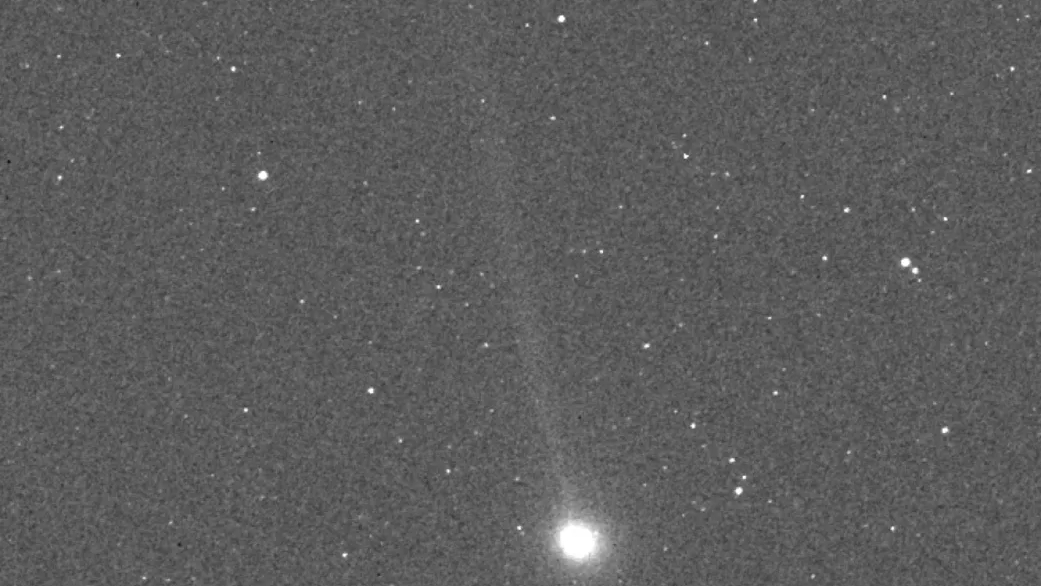Phew! No 'doomsday' asteroids hide in famous broken comet's debris stream
"We can probably sleep better knowing these results."

A swarm of interplanetary dust, rocks, comets and asteroids thought to be responsible for two famous impacts here on Earth has been found to be not quite as menacing as astronomers had feared.
"Our findings suggest that the risk of being hit by a large asteroid in the Taurid swarm is much lower than we believed, which is great news for planetary defense," said astronomer Quanzhi Ye of the University of Maryland in a statement. Ye led a search for the dangerous asteroids with the Zwicky Transient Facility on the Samuel Oschin Telescope at California's Palomar Observatory.
The swarm in question is the Taurid Meteoroid Complex, which is a huge trail of debris that cuts across the path of Earth's orbit around the sun. It's responsible for several meteor showers, most notably the Southern Taurids that peak every year on Nov. 5, and the Northern Taurids on Nov. 12. Meteor showers are produced when swarms of tiny particles of dust, most just microns — millionths of a meter — in size, burn up in the Earth's atmosphere. However, lurking among all the dust are larger chunks, from boulder-size rocks to full-blown asteroids. They all seem to come from a parent body, the short-period Comet 2P/Encke.
Comet 2P/Encke was the second periodic comet to be discovered. And the first, you ask? Halley's Comet, of course. A short-period comet is one that regularly orbits the sun more often than once every 200 years. (Comets that take longer than 200 years to complete an orbit are called long-period comets, and originate from deep within the distant Oort Cloud.) In 2P/Encke's case, it orbits every 3.3 years, the shortest orbit of any known periodic comet.
Related: Comets: Everything you need to know about the 'dirty snowballs' of space
Encke is pretty big for a short-period comet, spanning about 3 miles (4.8 kilometers) in diameter. It's also joined on its orbit by dozens of other minor bodies; a survey in 2020 cataloged 88 large members of the Taurid Complex. The theory is that 2P/Encke and all its companions originated from a much larger body that fragmented as it came in from the outer solar system and got close to the heat of the sun. Estimates of when this occurred vary, from about 20,000 years ago to just 5,000 to 6,000 years ago, but the worry was that there may be kilometer-sized objects lurking in the Taurid Complex that we haven't discovered yet. Objects of this size could cause widespread damage were they to collide with our planet.
However, having surveyed a wide swathe of sky around the Taurid Complex looking for any undiscovered objects, Ye's team announced at the American Astronomical Society's Division for Planetary Sciences annual meeting on Oct. 7 that there are fewer kilometer-sized objects in the Taurid Complex than had been thought.
Breaking space news, the latest updates on rocket launches, skywatching events and more!
"Fortunately, we found that it's likely there may only be a handful of asteroids — perhaps only nine to 14 of them — that fit this large size class in the swarm," said Ye. "Judging from our findings, the parent object that originally created the swarm was probably closer to 10 kilometers [6.2 miles] in diameter rather than a massive 100-kilometer [62 miles] object."
Some uncertainty does remain over the origin of the Taurid Complex, however. In 2014, astronomers using NASA's Infrared Telescope Facility on Mauna Kea, Hawaii, studied the spectra of many of the objects in the Taurid Complex and found a wide range of types, from stony S-type asteroids to carbon-rich C-types. This diversity called into question the idea that they'd all originated from a common parent body. However, a year later, a subsequent study that analyzed the spectra of 33 fireballs hailing from the Taurid Complex concluded that, despite the compositional variation, the fireballs all had spectral and physical characteristics consistent with having come from a comet that has broken apart.
Regardless of their origin, and despite being linked to the last two destructive impacts on Earth — the 1908 Tunguska event and the 2013 Chelyabinsk airburst — it seems that the Taurid Complex does not harbor any hidden dangers. The objects that are present within the stream are on well-known orbits and do not currently pose a threat to Earth.
Yet Ye suggests that we shouldn't get too comfortable. "We still need to be vigilant about asteroid impacts," he said. But, he added, "we can probably sleep better knowing these results."

Keith Cooper is a freelance science journalist and editor in the United Kingdom, and has a degree in physics and astrophysics from the University of Manchester. He's the author of "The Contact Paradox: Challenging Our Assumptions in the Search for Extraterrestrial Intelligence" (Bloomsbury Sigma, 2020) and has written articles on astronomy, space, physics and astrobiology for a multitude of magazines and websites.
